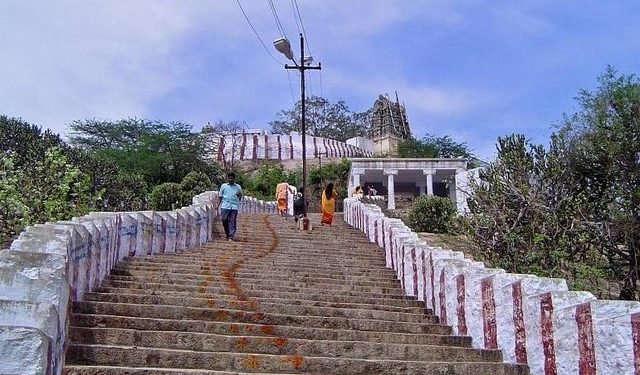Sri Yoga Narasimha Swamy Temple is dedicated to the Hindu god Vishnu.It is one of the 108 Divyadesam dedicated to Vishnu, who is worshipped as Lakshmi Narasimhar and his consort Lakshmi as Thirumamagal.There are three separate shrines of Vishnu in the form of Narsimha, Bhaktavatsala Perumal and Hanuman.They are situated on the larger hill,at the base of the larger hill and on the smaller hill respectively.
Shrine’s History
The place was originally called as Chozhsimhapuram, which later became Sholinghar. Various scriptures quote the place as Kadigachalam or Thirukadigai as the place is believed to offer blessings to devotees with a worship lasting a Kadigai . Peyazhwar refers the presiding deity as “Vaan Poonkadigai Ilankumaran”, while based on legend the presiding deity is also called Bhakotchita Swami. Vishnu Purana and Padma Purana refer this place as Kadigai and since Vishwamitra got his Brahmarishi title here, it became Simhapuram. The temple has many inscriptions at the foothills and also on the top of the hill.
They indicate generous contributions from Kulothunga Chola III Mayuravarman and Seeyagangan. Some the inscriptions indicate that the idol Andal was newly installed as the original one was lost. Manavala Mamunigal is believed to have performed enunciation of Thirupavai at this place on the request of his disciple Erumbiappa. The town originally was under the control of Shaivites which is substantiated by the temple ruins near Parappan Kulam, in the valley between two hills. This is where original Sholinghur was situated. Unfinished Nandhis and Sthupas are found in numerous places in Sholinghur. The temple is seen as one of the famous temples of Narasimha and a powerful image of Hanuman. Sholingur was the scene of the battle between the British and Hyder Ali during July 1781, in which the British won
Legends Associated with This Shrine
As per Hindu legend, a demon king named Hiranyakasipu was troubling the Devas . He obtained limitless powers from Brahma that no human can kill him, neither could he be killed in the morning, noon or night nor in air, water or ground. Contrastingly, his son Prahlada was an ardent devotee of Vishnu, whom his father hated. Hiranyakasipu tried to kill Prahlada numerous times, just to be saved by the divine grace of Vishnu. During the last heated argument between the father and the son, Hiranyakasipu asked if Vishnu was present everywhere and went on to break a pillar with his weapon seeking to see Vishnu in it.
Vishnu, pleased by the devotion of Prahalada, took the avatar of Narasimha and came out of the opening in the pillar. Narasimha avatar was a lion-faced human and slayed Hiranyakasipu on an evening time in a doorway, which was neither land nor air. Ages past by when the sages were praying Narasimha to seek his blessings. They were guided by the pretext of Vishwamitra gaining the Rajarishi title with his prayers to Narasimha. The sages were troubled by demons named Kalan and Keyan in the region and they prayed to Rama, another avatar of Vishnu. Rama deployed Hanuman, his monkey lieutenant to slay the demons. Hanuman could not initially kill the demons and he prayed Narasimha to attain the holy conch and Chakra, with which he killed the demons. He also requested Narasimha to appear in Yogic posture atop the hill and he stayed in yogic posture in the opposite hill facing Narasimha
Architectural Relevance of This Shrine
The temple has twin hills, with the one of Yoga Narasimha called the Periya malai 750 ft tall and occupying an area of 1.25 acres . The top of the hill is approached through a flight of 1,305 steps. The temple at the top measures 200 ft by 150 ft and has a five-tiered gateway tower, the rajagopuram. Narasimha sits in a Yogic posture in a shrine facing East and is called Yoga Narasimha Swamy. The vimana, the tapering roof over the sanctum is called Hemakoti Viamanam. There is a separate shrine for his consort Amrithavalli Thayaar. Yoga Anjenayar Swamy temple of Hanuman is present in the second hill called Chinna malai 350 ft tall.
Yoga Anjenayar is sported with chathurpujam with a conch and chakaram in the upper hands and a Jeba malai and Jeba Shankaram in other two respectively. The image of the festival deity, Varadaraja, is housed in the lower shrine of the big hill. The lower shrine has images of Bhaktavatchala Perumal and Sudavalli Thayar. There is a four pillared hall midway to the top of the hill housing the images of Doddacharya and Sudarshana. The temple tanks are called Brahmatheertham as Brahma is believed to have performed penance at this place to propitiate himself from the sins of one of his five heads getting cut by Shiva. In modern times, devotees perform rites at the temple tank seeking blessing from their forefathers.
Shrine’s Map Location and How to Go There
By Road
Two National Highways ? NH 4 and NH 46 connect parts of the district to other parts of the country. NH 46 passes through Vaniyambadi,Ambur,Vellore and Arcot before joining NH 4 at Ranipet.
By Rail
The railway network in Vellore comes under the Southern Railways, with Vellore, Arakkonam and Jolarpettai forming the major railway junctions in the district.
By Air
The nearest airport is at Chennai.
Shrine Timings
08.00 am to 05.30 p.m.
Events Celebrated at This Shrine
Bramothsavam April or May
Narasimha Jayanthi, Vasantha Uthsavam May or June
Garuda Seva, Thiruvona Festival June or July
Andal Thiruadipora Festival, Gajendra Motcham July or August
Thirupavithrothsavam August or September
Navarathri Festival September or October
Diwali October or December
Karthigai Festival November or December
Vaikunta Ekadasi December or January
Float Festival, ThaiPoosam January or February
Dhavana Uthsavam, Masi float festival February or March
PanguniUthram March or April
Extra Information About this Shrine
Nearby Temple
Angalamman Temple
Golden Temple
Lakshmi Narasimhar Temple,
Narasinghapuram Ratnagiri Murugan Temple
Sri Chandramouleeswarar Temple
Sri Kalikambal Temple
Thirukkadigai Thiruparkadal













































